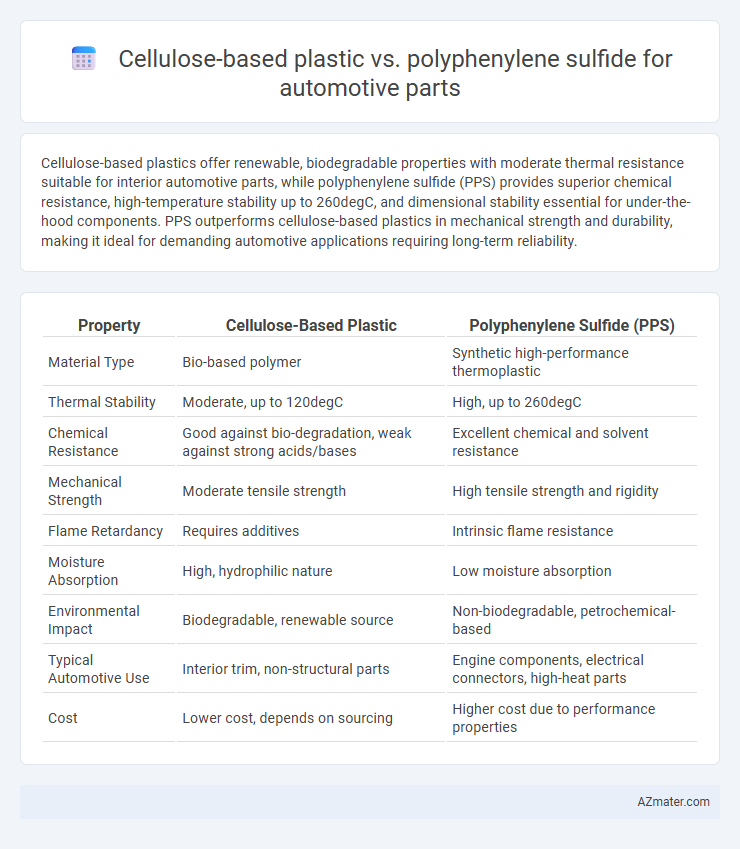Cellulose-based plastics offer renewable, biodegradable properties with moderate thermal resistance suitable for interior automotive parts, while polyphenylene sulfide (PPS) provides superior chemical resistance, high-temperature stability up to 260degC, and dimensional stability essential for under-the-hood components. PPS outperforms cellulose-based plastics in mechanical strength and durability, making it ideal for demanding automotive applications requiring long-term reliability.
Table of Comparison
| Property | Cellulose-Based Plastic | Polyphenylene Sulfide (PPS) |
|---|---|---|
| Material Type | Bio-based polymer | Synthetic high-performance thermoplastic |
| Thermal Stability | Moderate, up to 120degC | High, up to 260degC |
| Chemical Resistance | Good against bio-degradation, weak against strong acids/bases | Excellent chemical and solvent resistance |
| Mechanical Strength | Moderate tensile strength | High tensile strength and rigidity |
| Flame Retardancy | Requires additives | Intrinsic flame resistance |
| Moisture Absorption | High, hydrophilic nature | Low moisture absorption |
| Environmental Impact | Biodegradable, renewable source | Non-biodegradable, petrochemical-based |
| Typical Automotive Use | Interior trim, non-structural parts | Engine components, electrical connectors, high-heat parts |
| Cost | Lower cost, depends on sourcing | Higher cost due to performance properties |
Introduction to Automotive Plastics
Cellulose-based plastics offer renewable, biodegradable alternatives with high tensile strength and good thermal stability, making them suitable for interior automotive components aimed at sustainability. Polyphenylene sulfide (PPS) provides exceptional chemical resistance, dimensional stability, and high heat tolerance, ideal for under-the-hood parts exposed to harsh environments. Both materials contribute to lightweight vehicle design, enhancing fuel efficiency and reducing emissions while meeting specific performance requirements.
Overview of Cellulose-Based Plastics
Cellulose-based plastics are derived from renewable plant fibers, offering a sustainable alternative for automotive parts with excellent biodegradability and low environmental impact. These bioplastics provide good thermal stability and mechanical strength suitable for interior applications such as dashboards and door panels. Their lightweight nature contributes to overall vehicle weight reduction, enhancing fuel efficiency compared to traditional polyphenylene sulfide (PPS) plastics.
Polyphenylene Sulfide (PPS): Properties and Applications
Polyphenylene sulfide (PPS) is a high-performance thermoplastic known for its exceptional thermal stability up to 260degC, chemical resistance, and dimensional stability, making it ideal for demanding automotive parts such as under-the-hood components. PPS exhibits excellent mechanical strength, low moisture absorption, and inherent flame retardancy, which supports long-term durability and safety in harsh automotive environments. Compared to cellulose-based plastics, PPS offers superior performance in high-temperature applications, resistance to automotive fluids, and precise molding capabilities required for complex structural and functional parts.
Mechanical Strength Comparison
Cellulose-based plastics offer moderate tensile strength and high impact resistance, making them suitable for lightweight automotive interiors, but their mechanical strength is generally lower compared to polyphenylene sulfide (PPS). PPS exhibits exceptional mechanical strength, high rigidity, and thermal stability, enabling its use in demanding under-the-hood automotive components subjected to stress and heat. The superior impact resistance and chemical durability of PPS make it preferable for structural parts requiring long-term mechanical integrity.
Thermal Stability and Performance
Cellulose-based plastics offer moderate thermal stability with decomposition temperatures typically below 300degC, making them suitable for interior automotive parts but limiting their use in high-heat environments. Polyphenylene sulfide (PPS) exhibits exceptional thermal stability, maintaining mechanical performance at continuous operating temperatures up to 260degC and short-term exposure exceeding 300degC, ideal for under-the-hood components. PPS also provides superior chemical resistance and dimensional stability compared to cellulose-based plastics, enhancing long-term durability in demanding automotive applications.
Environmental Impact and Sustainability
Cellulose-based plastics offer significant environmental benefits in automotive applications due to their biodegradability and renewable origin, reducing carbon footprint and reliance on fossil fuels. Polyphenylene sulfide (PPS) provides exceptional thermal and chemical resistance, enhancing vehicle durability but relies on petrochemical sources, raising concerns about resource depletion and end-of-life recycling challenges. Sustainable automotive manufacturing increasingly favors cellulose-based materials to meet stringent environmental regulations and promote circular economy principles while balancing performance requirements.
Chemical Resistance: Cellulose-Based vs PPS
Polyphenylene sulfide (PPS) exhibits superior chemical resistance compared to cellulose-based plastics, making it highly suitable for automotive parts exposed to harsh chemicals, fuels, and solvents. Cellulose-based plastics, though biodegradable and renewable, tend to degrade or swell when in contact with oils or aggressive automotive fluids, limiting their application in chemically demanding environments. PPS maintains structural integrity and performance under extreme chemical exposures, contributing to its preference for engine components, fuel system parts, and under-the-hood applications.
Cost Efficiency in Automotive Manufacturing
Cellulose-based plastic offers a cost-effective alternative to polyphenylene sulfide (PPS) in automotive parts due to its renewable raw materials and lower production costs. PPS provides superior thermal stability and chemical resistance, but its higher manufacturing expenses impact overall cost efficiency in mass production. Evaluating lifecycle costs, including material sourcing and processing, cellulose-based plastics often reduce expenses while meeting moderate performance requirements in non-critical automotive components.
Processing and Fabrication Differences
Cellulose-based plastics offer biodegradability and are processed using conventional extrusion and injection molding with lower temperature requirements, making them suitable for eco-friendly automotive components. Polyphenylene sulfide (PPS) requires high-temperature processing, such as compression molding and injection molding at temperatures around 300degC, providing superior thermal stability and chemical resistance for demanding automotive applications. Fabrication of cellulose-based plastics is generally easier and more cost-effective, while PPS demands specialized equipment to handle its high melting point and to achieve optimal mechanical properties.
Future Trends in Automotive Material Selection
Cellulose-based plastics are gaining traction in automotive part manufacturing due to their biodegradability, lightweight properties, and renewable source, aligning with the industry's push towards sustainability. Polyphenylene sulfide (PPS) remains favored for its exceptional chemical resistance, thermal stability, and mechanical strength, crucial for high-performance under-the-hood components. Future trends indicate a growing integration of cellulose composites with high-performance polymers like PPS to create hybrid materials that balance environmental impact with durability and functionality in automotive applications.

Infographic: Cellulose-based plastic vs Polyphenylene sulfide for Automotive part
 azmater.com
azmater.com